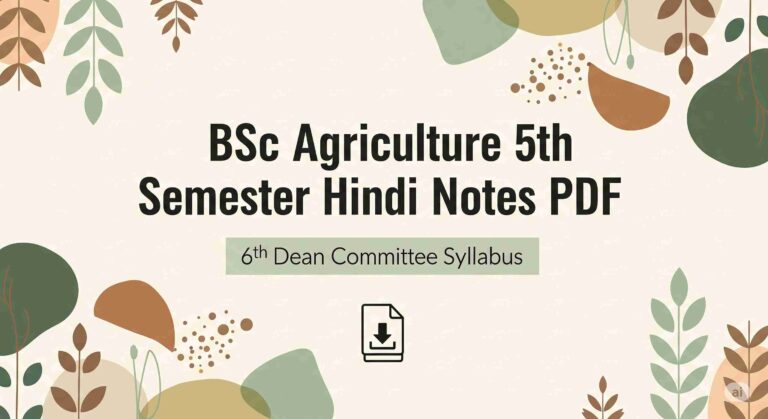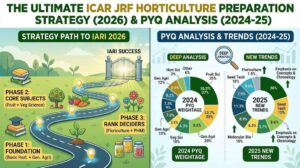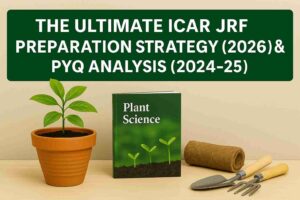Overview of BSc Agriculture 5th Semester Hindi Notes PDF
Need BSc Agriculture 5th Semester Hindi Notes PDF? Here you’ll find subject-wise, downloadable notes based on the latest 6th Dean Committee syllabus. Perfect for Hindi-medium students preparing for semester exams and agri-competitive tests.

Bsc agriculture 5th semester syllabus (6th dean committee)
5th semester subjects names (6th dean committee)

Download BSc Agriculture 5th Semester Hindi Notes PDF Subjects Wish
Agricultural Marketing and Trade 3 (2+1) PDF in Hindi
Introduction to Agro-meteorology 2(1+1) PDF in Hindi
Fundamentals of Crop Physiology 3(2+1) PDF in Hindi
Pest management in Crops and Stored Grains 3 (2+1) PDF in Hindi
Diseases of Field & Horticultural Crops & their Management 3(2+1) PDF in Hindi
Crop Improvement (kharif crops) - I 2 (1+1) PDF in Hindi
Weed Management 2 (1+1) PDF in Hindi
Ornamental Crops, MAPs and Landscaping 2 (1+1) PDF in Hindi
Introductory Agro forestry 2 (1+1) PDF in Hindi
Content covered in PDFs
1. Ornamentals crop and landscaping notes topics
- अलंकृत बागवानी: परिभाषा, इतिहास, महत्त्व एवं भविष्य (Ornamental Horticulture: Definition, History, Importance & Scope in India)
- एकवर्षीय पौधे: वर्गीकरण एवं खेती (Annual Plants: Classification & Cultivation)
- शाकीय किनारा (Herbaceous Border)
- झाड़ियाँ एवं झाड़ियों का समुदाय (झुरमुट) (Shrubs & Shrubberies)
- अलंकृत बाड़े एवं उनका वर्गीकरण (Ornamental Hedges & Their Classification)
- एजिंग (Edging)
- शोभाकार लतायें (Ornamental Climbers)
- सड़क के किनारे लगाने हेतु प्रमुख अलंकृत वृक्षों का अध्ययन (Study of Major Ornamental Trees for Roadside Planting)
- हरियाली का लगाना और देखभाल (Lawn Establishment and Maintenance)
- अलंकृत बागवानी की शैली (Styles of Ornamental Gardening)
- जापानी उद्यान (Japanese Garden)
- शैल उद्यान (Rock Garden)
- जल उद्यान एवं लिलीपूल (Water Garden & Lily Pool)
- गृह वाटिका एवं अन्तः गृह उद्यान (Home Garden & Indoor Garden)
- अलंकृत पौधों को गमलों में उगाना (Growing Ornamental Plants in Pots)
- लटकती टोकरियाँ (Hanging Baskets)
- हाइड्रोपॉनिक्स (Hydroponics)
- स्थल जीवशाला एवं जल जीवशाला (Terrarium & Aquarium)
- बोनसाई (Bonsai)
- आर्किड (Orchid)
- गुलाब की खेती (Rose Cultivation)
- गुलदाउदी की खेती (Chrysanthemum Cultivation)
- डहेलिया की खेती (Dahlia Cultivation)
- ग्लेडियोलस की खेती (Gladiolus Cultivation)
- रजनीगंधा की खेती (Tuberose Cultivation)
- कारनेशन की खेती (Carnation Cultivation)
- जरबेरा की खेती (Gerbera Cultivation)
- गेंदा की खेती (Marigold Cultivation)
- चाइना एस्टर की खेती (China Aster Cultivation)
- एन्थूरियम की खेती (Anthurium Cultivation)
- आल्स्ट्रोमेरिआ की कृषि (Alstroemeria Cultivation)
- केली की खेती (Calla Lily Cultivation)
- चमेली प्रजाति के पौधों की खेती (Jasmine Cultivation)
- कामनी की कृषि (Kamini Cultivation)
- बोगेनविलिया की कृषि (Bougainvillea Cultivation)
- कटाई के उपरान्त कटे फूलों का प्रबन्धन (Post-Harvest Management of Cut Flowers
2. Weed management notes topics
- Characteristics of Weed
- Demerits of Weeds
- Merits of Weeds
- Classification of Weed (Based on Seed Type, Life Cycle, Habitat, Origin, Crop-Weed Association, Propagation, Suitability of Land & Water, Leaf Structure)
- Objectionable Weeds
- Dispersal of Weeds
- Herbicide Classification (Based on Selectivity, Type of Weed Control, Movement in Plants, Application Site, Residues, Chemical Classification)
- Adjuvant
- Surfactants
- Lethal Dose (LD50)
- Formulation (PE, PPI, POST, LAYBY, EC, G, WP, SC, AI, AE)
- Application Methods of Herbicides (Soil applied, Foliage applied)
- Application Time of Herbicides
- Formulation of Herbicides
- Active Ingredients
- Acid Equivalent
- Types of Allelopathy
- Allelopathy
- Weedicide or Herbicide Calculation (Rate of application, Weed Index, Weed Control Efficiency, Weed Density, Weed Control Index)
- Concept of Weed
- Herbicide Resistance (Weeds and Reasons for Resistance)
- Factors Affecting Herbicide Resistance
- Mechanism of Resistance
- Cross Resistance
- Multiple Resistance
- Negative Cross Resistance
- Management of Weed Resistance (Cultural practices, Alternative herbicide, Transgenic crop, Crop rotation)
- Bioherbicide
- Importance of Bioherbicides
- Characteristics of Bioherbicides
- Limitations of Bioherbicides
- Benefits of Biological Control
- Herbicide Mixture
- Types of Herbicide Mixture
- Advantages of Herbicide Mixture
- Formulation of Herbicide
- Herbicide Activity
- Herbicide Selectivity
- Factors Affecting Selectivity (Plant factors, Chemical factor, Environmental factor)
- Compatibility (Herbicide Compatibility with other agrochemicals)
- Integration of Herbicides (Non-chemical, Biological, Mechanical)
- Mode of Action of Herbicide
- Mechanism of Action of Herbicide
3. Agro-meteorology notes topics
- Meaning and Scope of Agricultural Meteorology
- Earth’s Atmosphere – Its Composition, Extent and Structure
- Atmospheric Weather Variables; Atmospheric Pressure, its Variation with Height
- Wind, Types of Wind. Daily and Seasonal Variation of Wind Speed
- Cyclone, Anticyclone, Land Breeze and Sea Breeze
- Nature and Properties of Solar Radiation, Solar Constant, Depletion of Solar Radiation
- Short Wave, Long Wave and Thermal Radiation, Net Radiation, Albedo
- Atmospheric Temperature, Temperature Inversion, Lapse Rate, Daily and Seasonal Variations of Temperature, Vertical Profile of Temperature
- Energy Balance of Earth; Atmospheric Humidity, Concept of Saturation, Vapor Pressure
- Process of Condensation, Formation of Dew, Fog, Mist, Frost, Cloud
- Precipitation – Process, Types such as Rain, Snow, Sleet, and Hail
- Cloud Formation and Classification; Artificial Rainmaking
- Monsoon – Mechanism and Importance in Indian Agriculture
- Weather Hazards – Drought, Floods, Frost, Tropical Cyclones and Extreme Weather Conditions such as Heat-wave and Cold-wave
- Agriculture and Weather Relations; Modifications of Crop Microclimate, Climatic Normals for Crop and Livestock Production
- Weather Forecasting – Types of Weather Forecast and their Uses
- Climate Change, Climatic Variability, Global Warming, Causes of Climate Change and its Impact on Regional and National Agriculture
4. Agricultural Marketing notes topics
- Producer Surplus (Meaning, Types, Factors Affecting)
- Marketing Channels (Meaning, Definition, for Different Products)
- Market Efficiency (Meaning, Definition, Types, Estimation Methods)
- Marketing Cost (Meaning, Definition, Factors Affecting, Reasons for Higher Cost, Ways of Reducing)
- Marketing Margins (Meaning, Definition, Types)
- Price Spread
- Market Integration (Meaning, Definition, Types)
- Risk in Marketing (Meaning, Definition, Types, Minimizing)
- Speculation (Meaning, Types, Economic Benefits)
- Hedging (Meaning, Definition, Benefits, Comparison with Speculation)
- Future Trading
- GATT (General Agreement on Tariffs and Trade)
- WTO (World Trade Organization)
- AOA (Agreement on Agriculture) in WTO
- Warehousing (Meaning, Central Warehousing Corporation, State Warehousing Corporation, Advantages)
- Food Corporation of India (FCI)
- International Trade (Concept, Definition, Factors Affecting, Theories, Disadvantages, Advantages)
- Agricultural Price Policy (Meaning, Definition, Objective, Needs)
- Co-operative Marketing (Meaning, Definition, Objective, Advantages)
- AGMARK (Symbol, Objective, Description, Limitation, Quality Control)
- DMI (Directorate of Marketing and Inspection)
- CACP (Commission for Agricultural Costs & Prices)
5. Introductory Agroforestry notes topics
- Forestry: Definition, History and Terminology (वानिकी परिभाषा, इतिहास एवं शब्दावली)
- Silviculture: Definition and Objective (वनवर्धन परिभाषा एंव उद्देश्य)
- Elementary Idea of Types of Forests (वनों के प्रकारों का प्रारम्भिक विचार)
- Afforestation (वृक्षारोपण)
- Indian Forest Policy (राष्ट्रीय वन नीति)
- Regeneration of Forests: Natural & Artificial Regeneration (वनों का पुनर्जनन : प्राकृतिक एवं कृत्रिम)
- Tending Operations (प्रवृत्त प्रक्रियायें)
- Forest Mensuration (वन क्षेत्रमिति)
- Measurement of Trees (पेड़ों का मापन)
- Agro Forestry – Definition, Importance and Uses (कृषि वानिकी—परिभाषा, महत्त्व एवं उपयोग)
- Agro-Forestry: Present Status & Future (कृषि वानिकी- वर्तमान स्थिति तथा भविष्य)
- Classification of Agro Forestry (वानिकी का वर्गीकरण)
- Propagation of Forest Plants (वन पौधों का प्रवर्धन)
- Management of Forests (वन प्रबन्ध)
- Types of Forest Plantation (वन रोपण के प्रकार)
- Forest Products (वन उत्पाद)
- Economics of Agro Forestry (कृषि वानिकी का अर्थशास्त्र)
- Definition of Forest and its History (वन की परिभाषा एवं इतिहास)
- Natural and Artificial Ecosystem (Differences) (प्राकृतिक एवं कृत्रिम पारिस्थितिकी तंत्र में अंतर)
- Forestry Terminology (वन शब्दावली)
- Objectives of Silviculture (वनवर्धन के उद्देश्य)
- Forest and Trees: Importance, Distribution and Classification (वन एवं वृक्ष : महत्त्व, वितरण एवं वर्गीकरण)
- Advantages of Forests (वनों से लाभ)
- Forest Land and Its Distribution (वन क्षेत्र और उसका वितरण)
- Growth in Forests (वनों में वृद्धि)
- Trees and Parts of Tree (वृक्ष और वृक्ष के भाग)
6. Fundamentals of crop physiology notes topics
- वाष्पोत्सर्जन (Transpiration): This section discusses the process of transpiration, its types, significance (advantages and disadvantages), the mechanism of stomatal opening and closing, and factors affecting the rate of transpiration. It also covers antitranspirants, guttation, bleeding, and water use efficiency.
- प्रकाश संश्लेषण (Photosynthesis): This section details photosynthesis, its significance, historical overview, photosynthetic pigments, and the mechanism of photosynthesis (light and dark reactions, including Calvin cycle, Hatch-Slack cycle, and CAM). It also touches upon photorespiration, factors affecting photosynthesis, dry matter partitioning, harvest index, phloem loading, and assimilate movement.
- श्वसन (Respiration): This section explains respiration, its significance, types (aerobic and anaerobic), the mechanism (glycolysis, Krebs cycle, electron transport system), fermentation, and factors affecting respiration. It also discusses growth respiration, maintenance respiration, alternate respiration, salt respiration, and wound respiration.
- पोषण कार्यिकी (Nutriophysiology): This section covers mineral nutrition in plants, the major roles of mineral elements, their classification based on biochemical functions and quantitative need (macro and micro elements), the forms of nutrients absorbed, and the functions and deficiency/toxicity symptoms of various essential elements. It also describes nutrient solutions, hydroponics, aeroponics, foliar nutrition, and the physiology of nutrient uptake (passive and active absorption).
Download other semester notes PDF in Hindi.
BSc Ag. Semseter Name | Hindi Notes PDFs |
1st semester | |
2nd semester | |
3rd semester | |
4th semester | |
5th semester | |
6th semester |
Download other semester notes PDF in English
BSc Ag. Semseter Name | English Notes PDFs |
1st semester | |
2nd semester | |
3rd semester | |
4th semester | |
5th semester | |
6th semester |
Join our community
Click to Join Our Free WhatsApp Group and YouTube for Agriculture Updates!
Get daily updates, free study material, and the latest schemes, and connect with other agriculture students and farmers.
After bsc agriculture jobs syllabus
Latest Syllabus | Download Here |
IBPS Agriculture Filed Officer | |
NABARD GRADE A | |
Food Corporation of India (FCI) | |
RAEO | |
RHEO | |
Food Inspector | |
IFFCO AGT | |
MP PAT | |
UPSSSC AGTA |
Latest post
Fundamentals of Genetics by B.D. Singh Book PDF: A Comprehensive Review & Why It’s a Must-Have for Agri Students
Let’s be honest for a second—when most of us join...
Read MoreBest Books for ICAR JRF Horticulture 2026: The Topper’s Booklist (Updated)
Table of Contents Are you still dreaming of IARI relying...
Read MoreBest Books for ICAR JRF Plant Science 2026: The Ultimate Booklist (Updated)
Table of Contents Are you still planning to crack JRF...
Read MoreThe Ultimate ICAR JRF Agronomy Preparation Strategy (2026) & PYQ Analysis (2024-25)
Table of Contents Do you dream of walking into the...
Read MoreReferences
ICAR – Indian Council of Agricultural Research
https://icar.org.inBSMA Portal – ICAR Education Division
https://bsma.icar.gov.inAgriIndia.info
https://agriindia.infoAgriLearner.com
https://agrilearner.comAgriExam.com
https://agriexam.com






